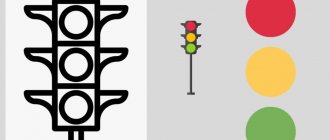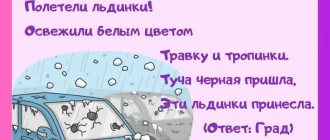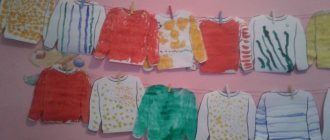Abstract of OOD in mathematics in the senior group. Days of the week
Synopsis of the cognitive development of children of senior preschool age on the topic: “Letter from the Queen of Mathematics”
Description of the material: I offer you a synopsis of the educational development for children of the older group (5 – 6 years old) on the topic: “Letter from the Queen of Mathematics.” This material will be useful for teachers of children of older preschool age. This is a summary of cognitive development on the development of children’s mathematical abilities, the ability to think, and answer questions correctly and clearly. Goal: development of thinking abilities and the ability to clearly and quickly answer questions. Tasks: - consolidate the names of the days of the week and their sequence; - develop the ability to identify special features of figures using visual analysis, to correlate the shapes of objects with geometric figures; — clarify knowledge about forward and backward counting; continue to learn how to solve addition and subtraction examples; - introduce the whole and its parts, teach how to divide an object into two or four parts; — cultivate goodwill, attentiveness, independence, and a desire to help. Integration of educational areas: “Cognitive development” “Socio-communicative development”. Preliminary work: d/i “Geometric figures”, “Match by shape”, “Geometric panel”; solving examples of addition and subtraction; individual work. Demonstration material: “Geometric panel”, envelopes of different colors, geometric shapes. Handouts: sets of geometric shapes, cards with numbers. Methodological techniques: game situation, physical exercise, individual work, surprise moment, analysis, reflection. Venue: group room.
Progress of the lesson
Children stand in a circle. Educator. Guys, we have guests today. Let's give them our smiles. Educator. I want to play a game with you. I will ask questions, and you answer quickly. Playing with a ball (the teacher throws the ball to the child and asks a question, the child returns the ball, answering it).
— What time of year is it now?
- Name the first month of spring. - Name the second month of spring. - Name the third month of spring. — Is it morning or evening? - What do we do during the day? - What do we do at night? — What day of the week is it today? — What day of the week is tomorrow? — What day of the week was yesterday? — What day of the week after Tuesday? — What day of the week before Saturday? — How many times a year does a birthday happen? Educator. Well done, you are very attentive and answered all the questions correctly. There is a knock and Swallow enters the group with envelopes. Martin. I am returning to my homeland from distant warm countries and bringing you letters. Educator. Thank you, dear Swallow. Guys, sit down at the table and let’s read the letter that Swallow brought us. This is a letter from the Queen of Mathematics. The teacher reads the letter and pays attention to the enclosed envelopes. Educator. How many envelopes did the Queen of Mathematics send? Pupils. Five. Educator. That's right - five. Let's open the first envelope. What colour is he? Pupils. Red. The teacher takes out geometric shapes - rectangle, circle, triangle, oval. Educator. What figure do you see here? Pupils. Rectangle. Educator. Name other geometric shapes. Children's answers. Educator. I will name the objects, and you will lay out on your table the geometric figure that this object resembles. Educator. Plate, door, house roof, cucumber, cube face. How can they be called in one word? Pupils. Geometric figures. Educator. How many figures are there in total? Pupils. Five. Educator. And now I propose to place all the geometric shapes in one house. A rectangle will live in the center of the sheet, a circle will live above the rectangle, an oval will live under the rectangle, a square will live to the right of the rectangle, and a triangle will live to the left. To make your home cozy, bright, and elegant, you need to decorate it. Place a sun in the upper left corner, a cloud in the upper right corner, and a Christmas tree in the lower right corner. Children complete the task. Educator. Let's open the envelope located between blue and white. What colour is he? Pupils. Yellow. Educator. And here are the numbers. Do you know what numbers are? These are the signs we use to denote numbers. There are only 10 numbers, but there are a lot of numbers. The numbers are mixed up. You need to build the correct number series. Almaz, name the neighbors of the number 5. Alina, name the neighbors of the number 7. Educator. Well done boys. You completed the task. And now I offer you the game “On the contrary”. To do this, we need to repeat the countdown. Well done, you did a very good job with the numbers. Kirill, call the countdown. PHYSICAL MINUTE On Monday I swam (pretend swimming) And on Tuesday I drew. (pretend to draw) On Wednesday I took a long time to wash my face, (we wash my face) And on Thursday I played football. (running in place) On Friday I jumped, ran, (jump) danced for a very long time. (spinning in place) And on Saturday, Sunday (claps hands) I rested all day (sleep). Educator. How many envelopes do we have left? Pupils. Three. Educator. Let's open the blue envelope. Game “Silent” I will ask you questions, and you will show me the answer to the questions with a card with a number. The most important condition is that you cannot speak in this game, you can only show the card. - How many fingers are on your right hand? — How many eyes does a traffic light have? — How many noses do two dogs have? — How many ears do two mice have? — How many tails do two cats have? That's right, they showed it. Well done! Educator. Let's open the non-green envelope. Which? Pupils. White. Educator. There is a circle here. It is necessary to divide it in half. What are these parts called? Pupils. Halves. Educator. How many guests can I serve if I split 1 apple in half? 2 apples? How many guests can you serve if you divide a pear into four parts? What are these parts called? Children's answers. Educator. We have one letter left. How can you tell about it what it is like? Pupils. Fifth and last. The Queen of Mathematics has hidden a surprise for you in this letter. You will find a surprise if Vlad stands up, turns left, takes 5 steps forward, turns right and takes 3 steps forward, turns left and opens what is in front of him. A child finds a treat from the Queen of Math. Educator. Now let's summarize our activities. What did you and I do today? Children's answers. Educator. Now everyone ask yourself: “Did I cope with the tasks today, or did I experience any difficulties?” Children's answers.
We recommend watching:
Summary of a lesson on the development of elementary mathematical concepts in the senior group Biography and creativity of the writer Yashin for children Summary of educational activities in the senior group on the topic: Winter Summary of educational activities on physical development for children of different age groups
Similar articles:
Summary of an integrated lesson in the senior group of kindergarten on the topic: Riddles
Abstract of GCD in mathematics in kindergarten in the senior group on the topic “Vertex, angle, side of a geometric figure”
Summary of a lesson on FEMP in the senior group of a preschool educational institution. Topic: “Composition of a number of units (number 7)”
Lesson notes on FEMP in the senior group. Count within 7
Math lesson notes “Number 6”. Senior group
So, what is a physical education minute and what do you eat it with?
A physical exercise is a short warm-up that takes place right in class. It helps students to distract themselves, relax and reorganize for the next stage of work. Therefore, most often physical training is carried out in the middle of the lesson, if necessary - more than once.
First of all, it is important to know that for normal health in the classroom, all sanitary standards must be observed:
- distances between desks and blackboard,
- thermal regime,
- focusing on objects in different parts of the class,
- sizes of desks and chairs,
- cleanliness of the premises,
- lighting intensity and much more.
Only when the classroom meets all standards can you be sure that the time that students spend in it will benefit them.
It is known that the muscles of the fingers, eyes and spine get tired the fastest, especially in children. Guys who have just learned to write think that they need to squeeze the pen tightly to make the letters straighter. In addition, physical education lessons at school compensate for only 11% of physical activity for children. And old, unpainted boards on which you can’t see anything are unlikely to train your eye muscles.
Charging for hands
How often do young schoolchildren get tired of their hands from writing and counting? These physical exercises in class will invigorate you and help you relax. Shake your hands to the beat of the lines from the poems, and also clench and unclench your fingers. .
* * *
We wrote, we wrote, Our fingers are tired, We'll rest a little and start writing again.
* * *
Here are my assistants, (we stretch our arms forward) Turn them any way you want. (turn the brushes in different directions) One, two, three, four, five. They knocked, turned (clap our hands) and wanted to work. Everyone sat down quietly.
* * *
Fingers do exercises to get less tired. And then they will write letters in a notebook. (Children stretch their arms forward, clench and unclench their fists.)
* * *
We bend our fingers together, clench our fists tightly. One, two, three, four, five - We begin to unbend. (Stretch your arms forward, clench your fingers into fists as tightly as possible, and then relax and unclench.)
* * *
To write beautifully to everyone, we need to stretch our fingers. They clenched their fists tightly and held them for a while. They held it and unclenched it. They showed me their palms. Do it quickly, kids. Now it's time for the letter.
* * *
As soon as we start to get tired, we’ll immediately unclench our fingers, we’ll spread them wider, we’ll strain them harder.
* * *
Let's intertwine our fingers and join our palms. And then, as soon as possible, we will squeeze it tightly.
* * *
Here are my helpers, turn them any way you want. One two three four five. They knocked, turned and wanted to work. Everyone sat down quietly.
Flower
The sun is rising - (Palms are raised up, fingers form a “bud”, the bases of the hands are pressed against each other). The flower is blooming! (At the same time we spread our fingers to the sides.) The sun sets - the flower goes to bed. (Put your fingers together.)




